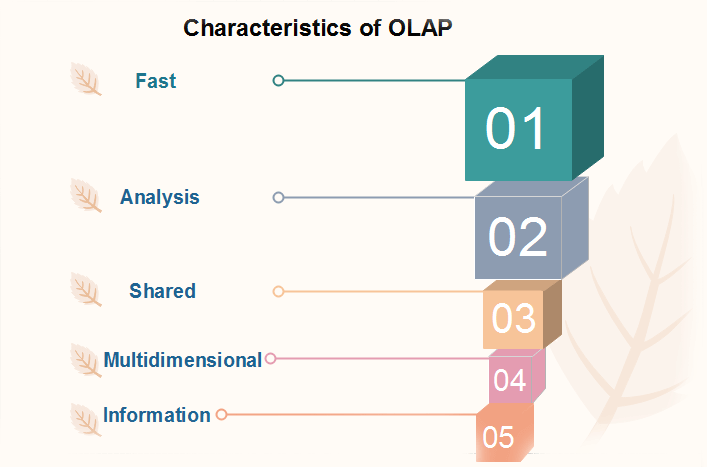Characteristics of OLAP
In the FASMI characteristics of OLAP methods, the term derived from the first letters of the characteristics are:

Fast
It defines which the system targeted to deliver the most feedback to the client within about five seconds, with the elementary analysis taking no more than one second and very few taking more than 20 seconds.
Analysis
It defines which the method can cope with any business logic and statistical analysis that is relevant for the function and the user, keep it easy enough for the target client. Although some preprogramming may be needed we do not think it acceptable if all application definitions have to be allow the user to define new Adhoc calculations as part of the analysis and to document on the data in any desired method, without having to program so we excludes products (like Oracle Discoverer) that do not allow the user to define new Adhoc calculation as part of the analysis and to document on the data in any desired product that do not allow adequate end user-oriented calculation flexibility.
Share
It defines which the system tools all the security requirements for understanding and, if multiple write connection is needed, concurrent update location at an appropriated level, not all functions need customer to write data back, but for the increasing number which does, the system should be able to manage multiple updates in a timely, secure manner.
Multidimensional
This is the basic requirement. OLAP system must provide a multidimensional conceptual view of the data, including full support for hierarchies, as this is certainly the most logical method to analyze business and organizations.
Information
The system should be able to hold all the data needed by the applications. Data sparsity should be handled in an efficient manner.
The main characteristics of OLAP are as follows:
- Multidimensional conceptual view: OLAP systems let business users have a dimensional and logical view of the data in the data warehouse. It helps in carrying slice and dice operations.
- Multi-User Support: Since the OLAP techniques are shared, the OLAP operation should provide normal database operations, containing retrieval, update, adequacy control, integrity, and security.
- Accessibility: OLAP acts as a mediator between data warehouses and front-end. The OLAP operations should be sitting between data sources (e.g., data warehouses) and an OLAP front-end.
- Storing OLAP results: OLAP results are kept separate from data sources.
- Uniform documenting performance: Increasing the number of dimensions or database size should not significantly degrade the reporting performance of the OLAP system.
- OLAP provides for distinguishing between zero values and missing values so that aggregates are computed correctly.
- OLAP system should ignore all missing values and compute correct aggregate values.
- OLAP facilitate interactive query and complex analysis for the users.
- OLAP allows users to drill down for greater details or roll up for aggregations of metrics along a single business dimension or across multiple dimension.
- OLAP provides the ability to perform intricate calculations and comparisons.
- OLAP presents results in a number of meaningful ways, including charts and graphs.
Benefits of OLAP
OLAP holds several benefits for businesses: –
- OLAP helps managers in decision-making through the multidimensional record views that it is efficient in providing, thus increasing their productivity.
- OLAP functions are self-sufficient owing to the inherent flexibility support to the organized databases.
- It facilitates simulation of business models and problems, through extensive management of analysis-capabilities.
- In conjunction with data warehouse, OLAP can be used to support a reduction in the application backlog, faster data retrieval, and reduction in query drag.
Motivations for using OLAP
1) Understanding and improving sales: For enterprises that have much products and benefit a number of channels for selling the product, OLAP can help in finding the most suitable products and the most famous channels. In some methods, it may be feasible to find the most profitable users. For example, considering the telecommunication industry and considering only one product, communication minutes, there is a high amount of record if a company want to analyze the sales of products for every hour of the day (24 hours), difference between weekdays and weekends (2 values) and split regions to which calls are made into 50 region.
2) Understanding and decreasing costs of doing business: Improving sales is one method of improving a business, the other method is to analyze cost and to control them as much as suitable without affecting sales. OLAP can assist in analyzing the costs related to sales. In some methods, it may also be feasible to identify expenditures which produce a high return on investments (ROI). For example, recruiting a top salesperson may contain high costs, but the revenue generated by the salesperson may justify the investment.
